 |
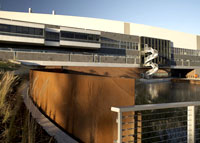 |
 |
 |
The site design for the new Swenson Science Building takes its cues from the concept of "Science on Display." Clad in steel, and surrounded by native plantings - resources unique to northern Minnesota - the courtyard features an experimental wetland garden, with an emphasis on the cultivation of wild rice. (Photo: George Heinrich, oslund.and.assoc.) |
 |
 |
 |
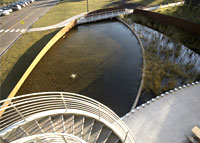 |
 |
 |
The site design for the new Swenson Science Building takes its cues from the concept of "Science on Display." Clad in steel, and surrounded by native plantings - resources unique to northern Minnesota - the courtyard features an experimental wetland garden, with an emphasis on the cultivation of wild rice. (Photo: George Heinrich, oslund.and.assoc.) |
 |
 |
 |
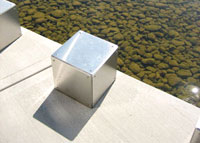 |
 |
 |
Sculptural stainless steel cubes define the edge of the experimental wetland garden and lower pool. (Photo: George Heinrich, oslund.and.assoc.) |
 |
 |
 |
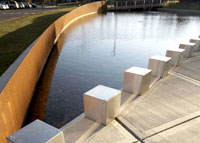 |
 |
 |
Sculptural stainless steel cubes define the edge of the experimental wetland garden and lower pool.
(Photo: George Heinrich, oslund.and.assoc.) |
 |
 |
 |
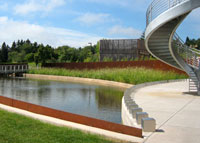 |
 |
 |
The site design for the new Swenson Science Building takes its cues from the concept of "Science on Display." Clad in steel, and surrounded by native plantings - resources unique to northern Minnesota - the courtyard features an experimental wetland garden, with an emphasis on the cultivation of wild rice. (Photo: George Heinrich, oslund.and.assoc.) |
 |
 |
 |
 |
 |
A stainless steel bridge slices through the elliptical form of the space, cutting through the wild rice wetland and over the lower pool. (Photo: George Heinrich, oslund.and.assoc.) |
 |
 |
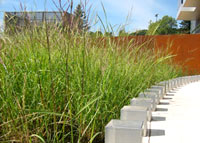 |
 |
 |
Sculptural stainless steel cubes define the edge of the experimental wetland garden and lower pool. (Photo: George Heinrich, oslund.and.assoc.) |
 |
 |
 |
 |
 |
 |
 |
 |
 |
 |
|
Click here for printer-friendly version |
 |
Project Statement
The site plan for the new Swenson Science Building takes its cues from the concept of "Science
on Display." Clad in steel, and surrounded by native plantings – resources unique to northern Minnesota
– the courtyard features an experimental wetland garden, with an emphasis on the cultivation of wild
rice. Chosen for its symbolism and importance to the Native American population of northern Minnesota, the
garden is an outdoor laboratory for UMD students and faculty.
“Science on Display” embraces the idea that “seeing” is critical to “understanding”,
thus the new Swenson Science Building (SSB) at University of Minnesota, Duluth, incorporates an atrium and glass-walled
classrooms, as well as interactive outdoor learning & contemplative spaces. Clad in steel, slate, and
brick, the SSB will be one of three landmark buildings that act as gateways onto campus. The building operates
as a bridge over one of the main campus arterials, tying the new space to existing science buildings. The act
of adding a sense of transparency to the design of both the interior and exterior rooms allows activities normally
conducted in opacity to be revealed. This helps those passing through the building to understand its function,
or at least have their interests piqued by what they see.
The landscape architect was charged with integrating the ideas of transparency, interior/exterior
relationships, and a working outdoor laboratory into usable, engaging spaces. The result features two outdoor
courtyards. The courtyards are designed as a transition space for pedestrian circulation and as a gathering
space for students, faculty, and staff. The upper courtyard will be located in the northwest elbow of the building.
It is intended to serve as a gathering space, as well
as a contemplative space. The upper courtyard will be
bordered with a grove of deciduous trees, a seat wall,
and will be accented with three sculptural cubes made
of perforated metal. The cubes are lit from within for
year round use. They act as a visual counterpoint for
contemplation within the plaza
The lower courtyard is located to the
south of the SSB. The lower courtyard features a two-tiered
experimental garden pool, which is separated by a curved
concrete weir. The pool also functions as a destination
for storm water runoff from the surrounding site and
roof of the SSB. The upper pool is a water garden with
a special emphasis on the cultivation of wild rice.
Wild rice was chosen for its symbolism and importance
to the Native American population of northern Minnesota.
It is an essential component to the Native American
way of life. Its incorporation into the water garden
allows for a subtle connection to and appreciation of
the Native American heritage. The landscape architect
worked very closely with tribal representatives as well
as science faculty to gain access to specimen wild rice
plants and to understand the specific needs for proper
cultivation. The landscape architect’s creative
skills were challenged by the need to integrate the
wild rice cultivation garden into a small section of
the larger water body. This was extremely difficult,
as wild rice must be cultivated in a very specific and
delicate environment. Unique underwater detailing, creating
a circulatory system for water flow suitable for wild
rice, and integrating pedestrian access to the water garden was
successfully achieved in the final design. Storm water
runoff is collected and discharged into the lower pool,
from which the water will be circulated to the upper
pool to maintain the water flow necessary for wild rice.
The garden is used as an outdoor laboratory for science
students and faculty. The talent of the landscape architect
is highlighted by the way in which all of these extremely
complex components have been integrated into a visually
simple, clean result.
Both courtyards take cues from the unique
north woods landscape that surrounds Duluth. New groves
of northern forest trees will compliment the two courtyard
designs. The trees will help tie the building and its
outdoor spaces to the campus landscape and to the overarching
northern Minnesota native ecosystem, quietly reinforcing
the idea that UMD is a uniquely northern Minnesota university.
The design of the SSB should be considered
for an award due to the landscape architect’s
thoughtful resolution of the many complex issues involved
in creating simple, elegant places that function both
aesthetically and scientifically. The design also succeeds
in creating a strong entry gateway to campus, while
highlighting the transparency ideal represented in the
‘Science on Display’ concept.
 |
 |
Project
Resources |
 |
 |
Landscape
Architect:
oslund.and.assoc. - Thomas Oslund
FASLA, FAAR; Misa Inoue, RLA
Architect of Record for
the building:
Stanius Johnson Architects, Inc.
Design Architect for the
building:
Ross Barney + Jankowski, Inc.
Structural Engineer:
Meyer, Borgman and Johnson, Inc.
Civil Engineer:
MSA Professional Services
|
 |
 |
 |
Mechanical
& Electrical Engineers:
Affiliated Engineers
General Contractor for the
building:
M.A. Mortenson
General Contractor for the
site work:
Max Gray Construction, Inc.
Cost Consultants:
Oscar J. Boldt Construction Co. |
 |
 |
 |
|
|
|
|
 |
 |
 |
 |
 |
 |
Conceptual sketches and models illustrate a complex design process that has integrated art and science within academic context of this space. (Photo: George Heinrich, oslund.and.assoc.) |
 |
 |
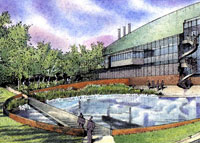 |
 |
 |
Conceptual sketches and models illustrate a complex design process that has integrated art and science within academic context of this space. (Photo: George Heinrich, oslund.and.assoc.) |
 |
 |
 |
 |
 |
 |
Conceptual sketches and models illustrate a complex design process that has integrated art and science within academic context of this space. (Photo: George Heinrich, oslund.and.assoc.) |
 |
 |
 |
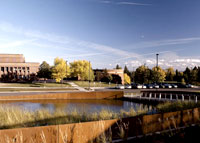 |
 |
 |
The pond and wild rice garden, as situated in the campus context on a main entry drive. (Photo: George Heinrich, osland.and.assoc.) |
 |
 |
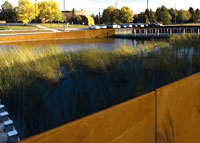 |
 |
 |
The landscape architect worked very closely with tribal representatives as well as Science faculty to gain access to specimen wild rice plants and to understand the special needs for proper cultivation. This was extremely difficult, as wild rice must be cultivated in a very special and delicate environment. Unique underwater detailing, creating a circulatory system for water flow suitable for wild rice, and integrating pedestrian access to the water garden was successfully achieved in the final design. (Photo: George Heinrich, oslund.and.assoc.) |
 |
 |
 |
 |
 |
The garden as seen at sunset. The weir separating the wild rice garden from the lower pool reveals a simple solution to a complex design challenge of separating uses for a complex biological process. (Photo: George Heinrich, oslund.and.assoc.) |
 |
 |
|
 |